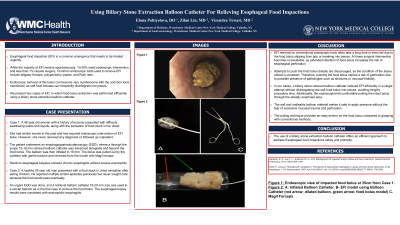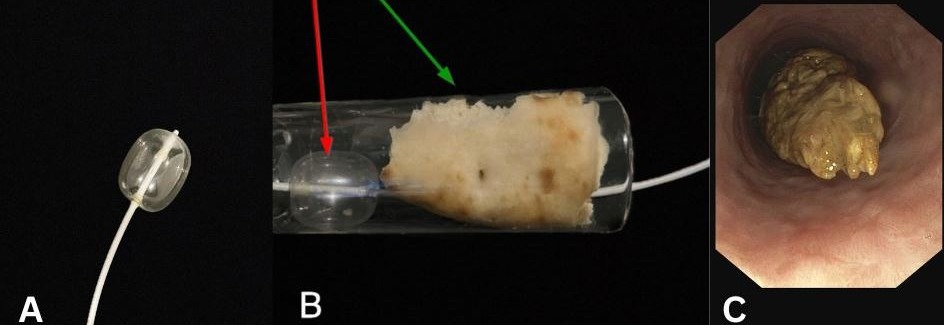Monday Poster Session
Category: General Endoscopy
P2418 - Using Biliary Stone Extraction Balloon Catheter for Relieving Esophageal Food Impactions
Monday, October 28, 2024
10:30 AM - 4:00 PM ET
Location: Exhibit Hall E

Has Audio

Elona Poltiyelova, DO
Westchester Medical Center
Valhalla, NY
Presenting Author(s)
Award: Presidential Poster Award
Elona Poltiyelova, DO, Zilan Lin, MD, Virendra Tewari, MD, FACG
Westchester Medical Center, Valhalla, NY
Introduction: The prevalence of esophageal food impaction (EFI) is rising, particularly in the context of the growing incidence of eosinophilic esophagitis (EoE). While the majority of EFI resolve spontaneously, 10-20% need endoscopic intervention, and less than 1% require surgery. Common tools used to remove EFI include alligator forceps, polypectomy snares, and Roth nets. We present two cases of EFI, in which food bolus extraction was performed efficiently using a biliary stone extraction balloon catheter.
Case Description/Methods: 1. A 48 year old woman with a history of eczema presented with difficulty swallowing solids and liquids, along with the sensation of pork stuck in her chest. She had similar events in the past and has required endoscopic intervention of EFI twice. However, she never received any diagnosis or followed up outpatient. Vital signs were stable on admission, and she was protecting airway. The patient underwent an EGD where a through the scope 15-18 mm retrieval balloon catheter was advanced alongside and beyond the food bolus, and the balloon was inflated to 18 mm. The bolus was pulled out by the catheter with gentle traction and removed from the mouth with Magil forceps. The patient tolerated the procedure well and was discharged. The random esophageal biopsies showed chronic esophagitis without excess eosinophils.
2. A 26 year old man presented with a food stuck in chest sensation after eating chicken. He reported similar episodes previously but never sought care because the food would pass eventually. An urgent EGD was done, and a retrieval balloon catheter was used in a similar fashion as in the first case to remove the food bolus. The esophageal biopsy results were consistent with EoE.
Discussion: EFI removal by conventional endoscopic tools often take a long time or even fail due to the food bolus slipping from grip or breaking. Attempts to push the food bolus distally carry a risk of perforation due to the presence of unknown pathology and should be avoided.
In our cases, a biliary stone retrieval balloon catheter relieved EFI efficiently in a single attempt without disintegrating it, avoiding lengthy procedure time. The soft and malleable balloon material makes it safe to apply pressure without the fear of excessive mucosal trauma and perforation. The pulling technique provides an easy anchor on the food bolus compared to grasping with conventional methods.
In conclusion use of a biliary stone extraction balloon offers an efficient approach to address EFI safely and promptly.

Disclosures:
Elona Poltiyelova, DO, Zilan Lin, MD, Virendra Tewari, MD, FACG. P2418 - Using Biliary Stone Extraction Balloon Catheter for Relieving Esophageal Food Impactions, ACG 2024 Annual Scientific Meeting Abstracts. Philadelphia, PA: American College of Gastroenterology.
Elona Poltiyelova, DO, Zilan Lin, MD, Virendra Tewari, MD, FACG
Westchester Medical Center, Valhalla, NY
Introduction: The prevalence of esophageal food impaction (EFI) is rising, particularly in the context of the growing incidence of eosinophilic esophagitis (EoE). While the majority of EFI resolve spontaneously, 10-20% need endoscopic intervention, and less than 1% require surgery. Common tools used to remove EFI include alligator forceps, polypectomy snares, and Roth nets. We present two cases of EFI, in which food bolus extraction was performed efficiently using a biliary stone extraction balloon catheter.
Case Description/Methods: 1. A 48 year old woman with a history of eczema presented with difficulty swallowing solids and liquids, along with the sensation of pork stuck in her chest. She had similar events in the past and has required endoscopic intervention of EFI twice. However, she never received any diagnosis or followed up outpatient. Vital signs were stable on admission, and she was protecting airway. The patient underwent an EGD where a through the scope 15-18 mm retrieval balloon catheter was advanced alongside and beyond the food bolus, and the balloon was inflated to 18 mm. The bolus was pulled out by the catheter with gentle traction and removed from the mouth with Magil forceps. The patient tolerated the procedure well and was discharged. The random esophageal biopsies showed chronic esophagitis without excess eosinophils.
2. A 26 year old man presented with a food stuck in chest sensation after eating chicken. He reported similar episodes previously but never sought care because the food would pass eventually. An urgent EGD was done, and a retrieval balloon catheter was used in a similar fashion as in the first case to remove the food bolus. The esophageal biopsy results were consistent with EoE.
Discussion: EFI removal by conventional endoscopic tools often take a long time or even fail due to the food bolus slipping from grip or breaking. Attempts to push the food bolus distally carry a risk of perforation due to the presence of unknown pathology and should be avoided.
In our cases, a biliary stone retrieval balloon catheter relieved EFI efficiently in a single attempt without disintegrating it, avoiding lengthy procedure time. The soft and malleable balloon material makes it safe to apply pressure without the fear of excessive mucosal trauma and perforation. The pulling technique provides an easy anchor on the food bolus compared to grasping with conventional methods.
In conclusion use of a biliary stone extraction balloon offers an efficient approach to address EFI safely and promptly.

Figure: A- Inflated Balloon Catheter. B- EFI model using Balloon Catheter (red arrow: dilated balloon, green arrow: food bolus model). C- Endoscopic view of impacted food bolus at 35cm from Case 1.
Disclosures:
Elona Poltiyelova indicated no relevant financial relationships.
Zilan Lin indicated no relevant financial relationships.
Virendra Tewari indicated no relevant financial relationships.
Elona Poltiyelova, DO, Zilan Lin, MD, Virendra Tewari, MD, FACG. P2418 - Using Biliary Stone Extraction Balloon Catheter for Relieving Esophageal Food Impactions, ACG 2024 Annual Scientific Meeting Abstracts. Philadelphia, PA: American College of Gastroenterology.

